Addition with Regrouping - Ten
Basics on the topic Addition with Regrouping - Ten
3 Digit Addition with Regrouping and Base Ten Blocks
We can use place value charts and base ten blocks to help model addition with regrouping. Ones are represented with single squares, tens with columns of ten, and hundreds as cubes of one hundred. In a place value chart, we build the addends in blocks to add and regroup, or move the blocks from one place value to another. This helps us to solve equations more easily.
To begin, model your addends with base ten blocks in a place value chart. Add up the ones place. If the sum in the ones place is ten or greater, regroup as needed to the tens place and write the remaining total below. Next, add the tens place.If the sum in the tens place is ten or greater, regroup as needed to the hundreds place and write the remaining total below. Finally, count all the squares in the hundreds column and write the total below.
3 Digit Addition with Regrouping and Base Ten Blocks – Example
Let’s use two hundred sixty-five plus four hundred thirty-seven as an example to model three digit addition with regrouping base ten blocks.
Begin by modeling the equation with base ten blocks. Put the first addend blocks in the place value chart. Then, put the second addend blocks below it.
Start counting all the blocks in the ones column. There are twelve ones. Twelve is made up of one ten and two ones, so we need to regroup the set of ten. This set moves to the tens place. Two blocks are left in the ones column, so we write two below.
Now, move on to counting in the tens place. There are ten columns of ten which means we have one hundred in the TENS place. We need to regroup the one hundred from the tens place to the hundreds place. After we do this, the tens column is empty. We write a ZERO here to show there are no tens here anymore.
Finally, count the hundreds in the hundreds place. There are seven hundreds, so we write seven below the hundreds place.
3 Digit Addition with Regrouping and Base Ten Blocks – Summary of Steps
Here you can revise the necessary steps for three digit addition with regrouping and base ten blocks:
| Steps | What to do |
|---|---|
| 1 | Model your addends with base ten blocks in a place value chart. |
| 2 | Add up the ones place. If the sum in the ones place is ten or greater, regroup as needed to the tens place and write the remaining total below. |
| 3 | Add the tens place. If the sum in the tens place is ten or greater, regroup as needed to the hundreds place and write the remaining total below. |
| 4 | Count all the squares in the hundreds column and write the total below. |
3 Digit Addition with Regrouping and Base Ten Blocks – Exercises
Have you practiced yet? On this website, you can also find three (3) digit addition with regrouping base ten (10) blocks worksheets and exercises. These 3 digit addition with regrouping worksheets for 3rd grade will help get you started!
Transcript Addition with Regrouping - Ten
Mr. Squeaks and Imani successfully built a time machine to go dino gazing! On their two hundred million year journey back home, they are trying to add up all the amazing things they saw, but are having trouble regrouping their three-digit numbers! Let's help them by modeling... "Three Digit Addition with Regrouping - Base Ten Blocks." Remember, we can use place value charts and base ten blocks to help model addition with regrouping. Ones are represented with single squares, tens with columns of ten, and hundreds as cubes of one hundred. In a place value chart, we build the addends in blocks to add and regroup, or move the blocks from one place value to another. This helps us to solve equations more easily. First, Mr. Squeaks and Imani saw a herd of Diplodocus. There were one hundred forty-seven on the ridge and six more eating leaves in the valley. How many were there in all? We can model one hundred forty-seven plus six using base ten blocks in a place value chart. First, we represent each of our addends using base ten blocks. We put the first addend in the place value chart. Then, we put our second addend beneath it. Next, we begin to add by counting up all the blocks in the ones column. There are thirteen ones. Thirteen is made up of one ten and three ones, so we need to regroup. Regrouping means we will need to move a set of ten to the tens place. Three blocks are left, so we write three in the ones place. Now we count in the tens place. There are five tens. We write five below the tens place. Finally, we count the hundreds. Write one in the hundreds place. Wow, Mr. Squeaks and Imani saw one hundred fifty-three Diplodocus! They also stumbled upon a field of Stegosaurus footprints! The first set of prints had two hundred sixty-five footprints and the second had four hundred thirty-seven. How many footprints were there in all? Model the equation with base ten blocks. What comes next? We put the FIRST addend in the place value chart. Then, we put the second addend below it. Where do we start counting? Begin by counting all the blocks in the ones column. There are twelve ones. Twelve is made up of one ten and two ones, so we need to REGROUP the set of ten. Where does the set of ten regroup to? It regroup to the TENS place. Two blocks are left in the ones column, so we write two below. Move on to counting in the tens place. There are ten. We have ten tens which means we have one hundred in the TENS place. We need to regroup ONE hundred from the TENS place to the HUNDREDS place. The tens column is now empty, so write a ZERO here. Finally, count the hundreds. There are seven. Write seven below the hundreds place. Wow! Mr. Squeaks and Imani saw seven hundred and two Stegosaurus footprints! Before we see if Mr. Squeaks and Imani made it back to the present, let's remember! Model your addends with base ten blocks in a place value chart. Add up the ones place. If the sum in the ones place is ten or greater, regroup as needed to the tens place and write the remaining total below. Next, add the tens place. If the sum in the tens place is ten or greater, regroup as needed to the hundreds place and write the remaining total below. Finally, count all the squares in the hundreds column, and write the total below. "That's strange(...) it took us longer coming than going." "My weight calculations for the time machine have it heavier on the way back...oh well, it's probably nothing."
Addition with Regrouping - Ten exercise
-
Which number does each set of blocks represent?
HintsHow much is each one of these worth on their own?
If we add these base ten blocks together, we are adding 100 + 10 + 1 which equals 111.
SolutionThese base ten blocks represent the number 204.
Remember:
- the small green cubes are worth 1
- the long blue rods are made up of ten ones, so they are worth 10
- the large red squares are made up of ten tens rods, or 100 ones cubes, so are worth 100
20
- Two tens rods.
- 10 + 10 = 20
- Four tens rods and five ones cubes
- 1 + 1 + 1 + 1 + 1 = 5
- 10 + 10 + 10 + 10 = 40
- 40 + 5 = 45
- One hundred square, two tens rods and five ones cubes
- 1 + 1 + 1 + 1 + 1 = 5
- 10 + 10 = 20
- 100 + 20 + 5 = 125
- One hundred square and three tens rods
- 10 + 10 + 10 = 30
- 100 + 30 = 130
- As shown in the image
- Two hundred squares and four ones cubes
- 1 + 1 + 1 + 1 = 4
- 100 + 100 = 200
- 200 + 4 = 204
-
How many teeth did Mr. Squeaks and Imani see?
HintsRemember to start by adding in the ones column, then move to the tens, and then the hundreds.
Don't forget to carry over if you are left with a 2-digit number.
For example, if we were adding 28 + 17, we would add 8 + 7 to get 15. We would leave 5 ones in the ones column and carry the 10 across.
SolutionMr. Squeaks and Imani saw 272 teeth.
- We start by adding the ones. 7 ones plus 5 ones equals 12 ones. We then need to re-group the ten and write 2 in the ones place.
- We then add the tens. 2 tens plus 4 tens plus the ten we re-grouped equals 7 tens, so we write 7 in the tens place.
- We then add the hundreds. 1 hundred plus 1 hundred equals 2 hundred, so we write 2 in the hundreds place.
- 2 hundred plus 7 tens plus 2 ones equals 272.
-
Are these numbers correct?
HintsCheck that the hundreds have been counted correctly, then the tens, and then the ones.
For example, here there are 6 tens rods which equals 60.
SolutionOops! Mr. Squeaks and Imani have made a few mistakes!
Remember to look carefully at how many of each base ten blocks there are.
- The first number sentence should have read 100 + 30 + 4 because there are three tens rods, not two.
- The second number sentence should have read 200 + 40 + 7 because there are seven ones cubes, not eight.
- The third number sentence should have read 100 + 40 + 3. There is only one hundred square, not two, and there are four tens rods, not three.
- The fourth number sentence should have read 300 + 70 + 7. There are three hundred squares, not four. There are seven tens rods, not 8, and there are seven ones cubes, not eight.
-
How many leaves have the dinosaurs eaten?
HintsRemember to add the ones place first.
Don't forget to add anything you have carried over.
For example, if we add 13 + 8, we would add 3 + 8, which equals 11. We would leave the one in the ones column and carry a ten across.
SolutionHere is the answer for 134 + 247.
- We added 4 ones plus 7 ones, which equals 11 ones. We cannot put a two-digit number into the ones place, so we re-group ten ones into the tens column and write 1 in the ones column.
- We now have 3 tens plus 4 tens plus 1 ten, which equals 8 tens, so we write 8 in the tens column.
- 1 hundred plus 2 hundred equals 3 hundred, so we write 3 in the hundreds column.
- 3 hundred plus 8 tens plus 1 one equals 381.
143 + 379
- 3 ones plus 9 ones equals 12 ones. We re-group ten and write 2 in the ones column.
- 4 tens plus 7 tens plus 1 ten equals 12 tens. We re-group a hundred and write 2 in the tens column.
- 1 hundred plus 3 hundred plus 1 hundred equals 5 hundred, so we write 5 in the hundreds column.
- 5 hundred plus 2 tens plus 2 ones equals 522.
- 1 one plus 5 ones equals 6 ones, so we write 6 in the ones column.
- 2 tens plus 6 tens equals 8 tens, so we write 8 in the tens column.
- 1 hundred plus 1 hundred equals 2 hundred, so we write 2 in the hundreds column.
- 2 hundred plus 8 tens plus 6 ones equals 286.
- 8 ones plus 2 ones equals 10 ones. We re-group ten and write a 0 in the ones column.
- 4 tens plus 3 tens plus 1 ten equals 8 tens, so we write 8 in the tens column.
- 2 hundred plus 3 hundred equals 5 hundred, so we write 5 in the hundreds column.
- 5 hundred plus 8 tens plus 0 ones equals 580.
-
How many dinosaur bones did Mr. Squeaks see?
HintsRemember to start by adding the ones, then move to the tens, and then the hundreds.
Remember to check how many of each place value there are altogether, and place this number at the bottom.
SolutionMr. Squeaks saw 175 bones!
- 2 ones plus 3 ones equals 5 ones
- 1 ten plus 6 tens equals 7 tens
- 1 hundred plus 0 hundred equals 1 hundred
- When we put these together, we get a total of 175
-
Can you find the totals?
HintsIf you don't have any of your own base ten blocks, you could draw some like this to represent each number and then add them together.
If you are adding three numbers, you still follow the pattern of adding all of the ones first, then all of the tens, and then all of the hundreds. Don't forget to add any you have carried over.
SolutionMr. Squeaks and Imani saw 353 diplodocuses!
- We add 9 ones plus 4 ones which equals 13 ones. We re-group ten and write 3 in the ones column.
- We then add 2 tens plus 2 tens plus 1 ten which equals 5 tens, so we write 5 in the tens column.
- Finally, we add 1 hundred plus 2 hundreds which equals 3 hundreds, so we write 3 in the hundreds column.
- 3 hundreds + 5 tens + 3 ones equals 353.
Following the same method, Mr. Squeaks and Imani saw:
- 435 bones
- 452 pterodactyls
- 406 eggs
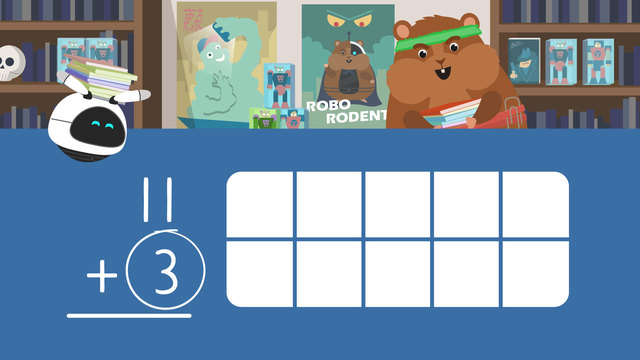
Adding a 1-Digit Number to a 2-Digit Number
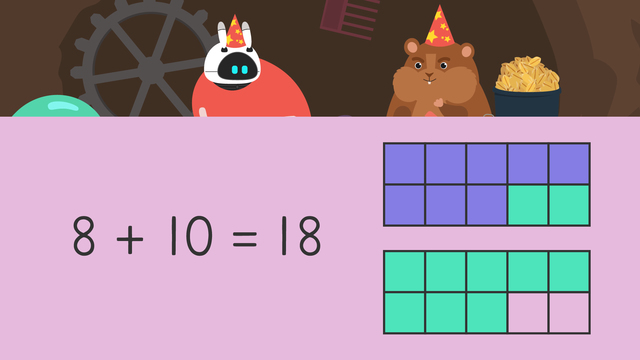
Order in Adding
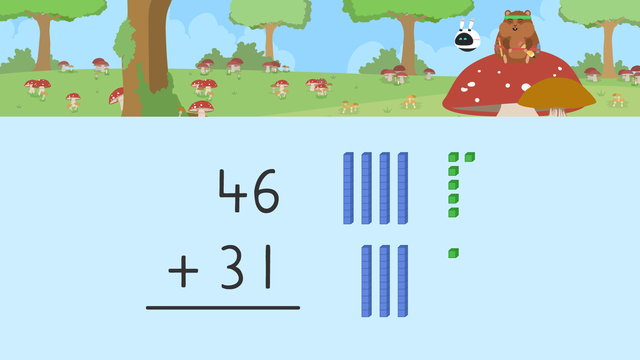
Using Place Value to Add
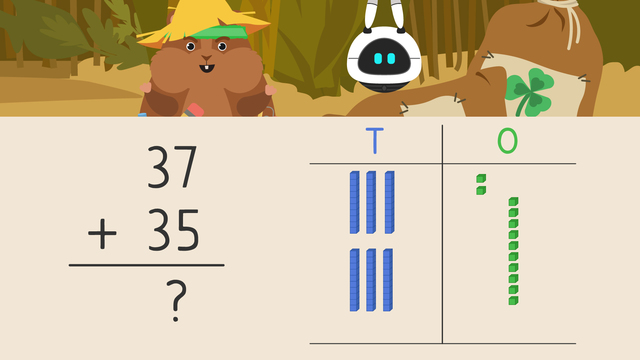
Using Place Value to Add Two Digit Numbers (Regrouping)
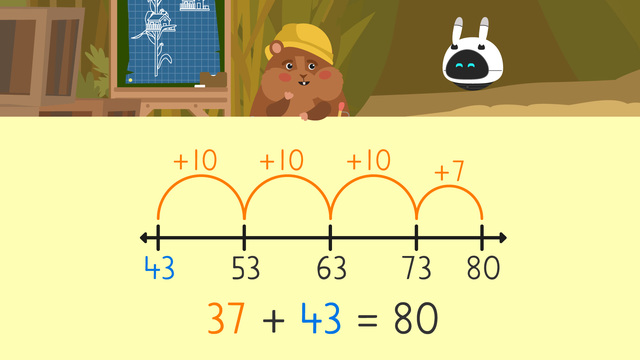
Make a Number Line to Add
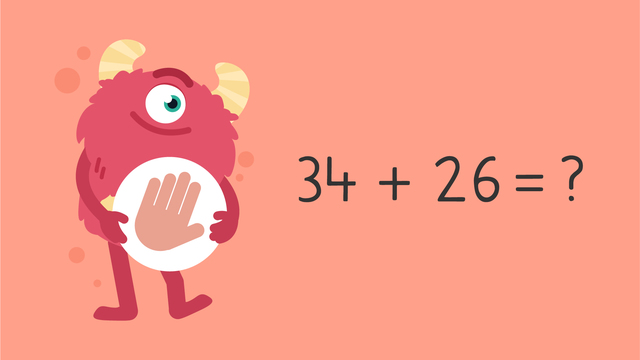
Make a Number Line to Add — Let's Practice!
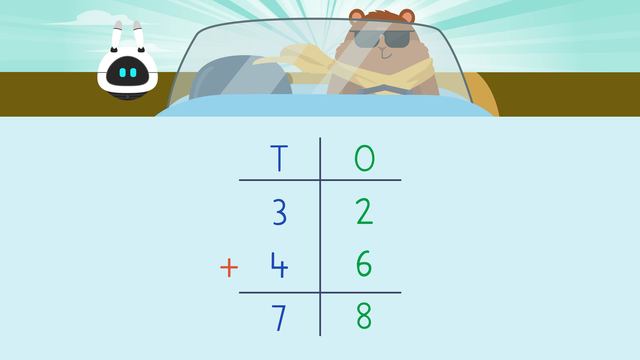
Addition Using Expanded Form
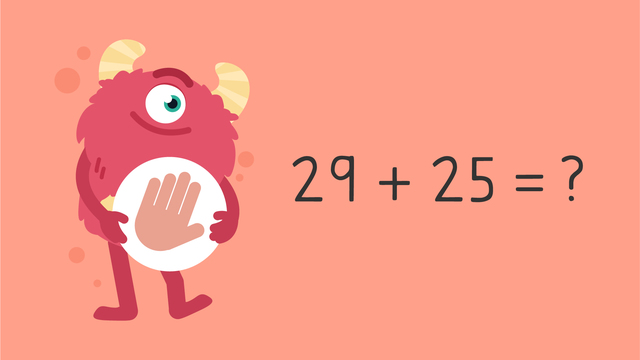
Compensation in Addition — Let's Practice!
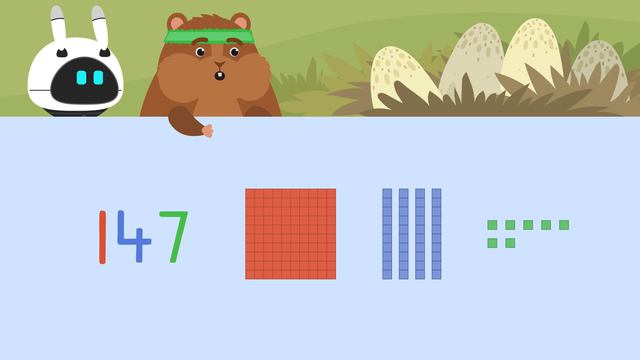
Addition with Regrouping - Ten
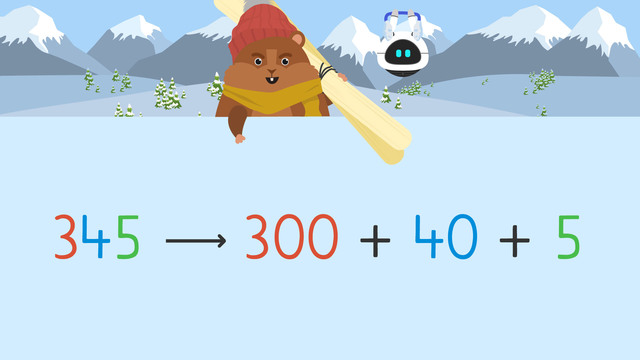
Three Digit Addition with Regrouping - Expanded Form
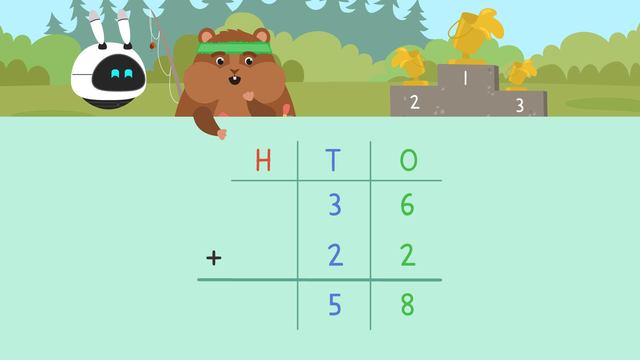
Adding 2 Digit Numbers Using Standard Algorithm
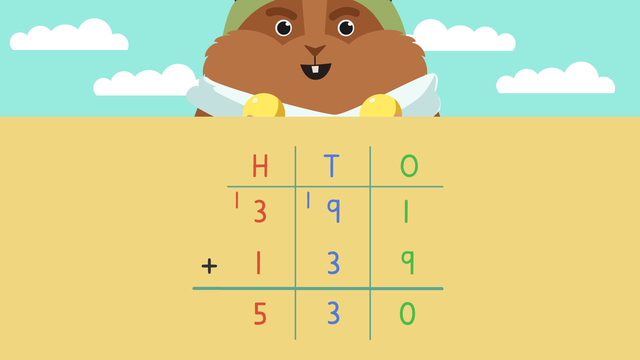
Adding 3 Digit Numbers Using Standard Algorithm
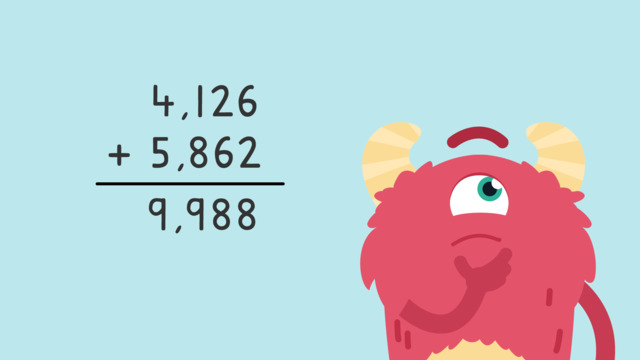
Adding Larger Numbers — Let's Practice!
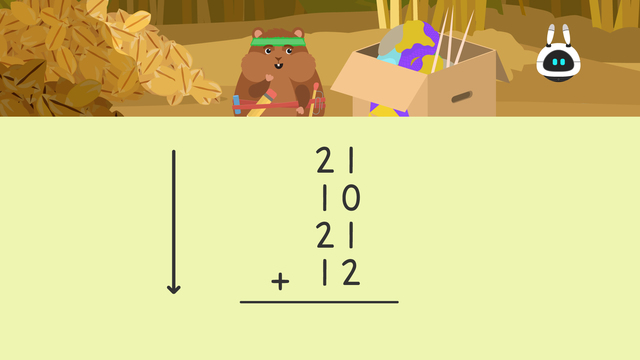
Adding Four Two Digit Numbers
















